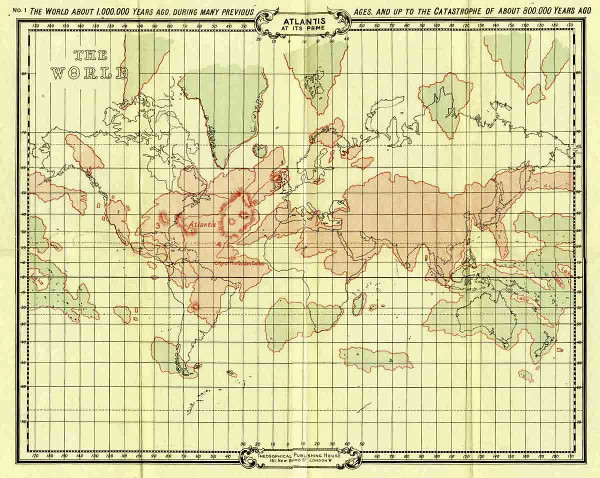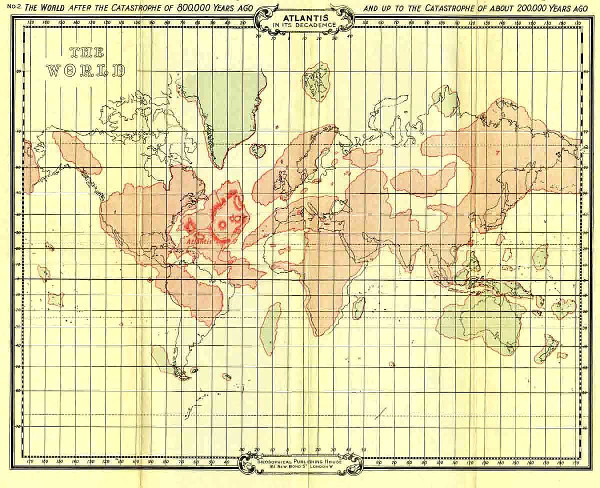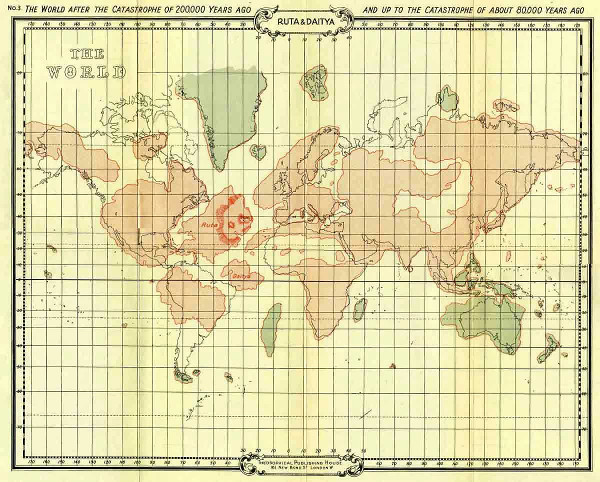
The famed American psychic Edgar Cayce (1877-1945) also referred to
Atlantis as fact - not as fable. In a number of his readings, he spoke
about past lives where people once had lived in Atlantis. Among Edgar
Cayce's 14,306 documented readings, exactly 700 - which is less then 5%
- mentioned Atlantis.
 According
to his readings; In the beginning, Atlantis was not a mere
island but a large continent of the size of Europe, including Asia in
Europe, that stretched from the Gulf of Mexico to the Mediterranean Sea.
Evidences of this lost civilization could be found in the Pyrenees and
Morocco at one side, and in British Honduros, Yucatan and America on
the other side of the world. Some parts including the British West
Indies and the Bahamas, once were part of that huge continent, and
the islands of the Azores once were its large mountain tops.
According
to his readings; In the beginning, Atlantis was not a mere
island but a large continent of the size of Europe, including Asia in
Europe, that stretched from the Gulf of Mexico to the Mediterranean Sea.
Evidences of this lost civilization could be found in the Pyrenees and
Morocco at one side, and in British Honduros, Yucatan and America on
the other side of the world. Some parts including the British West
Indies and the Bahamas, once were part of that huge continent, and
the islands of the Azores once were its large mountain tops.
The readings of Edgar Cayce suggest that 52,000 years ago, vulcanic eruptions and earthquakes started to cause a shift of the magnetic poles of the Earth which resulted in the loss of land in Atlantis and eventually became an archipelago of five islands. With the upheavals, the initial migrations from Atlantis took place in small numbers to the east and west. The earliest settlements were in the region of the Pyrenees in France and Spain and later in Central and South America.
“The discovery of this race [Cro-Magnon]... at once aroused profound interest in the scientific world, for the height and brain-capacity remarked in the skeletal specimens recovered was so extraordinary as to force anthropologists to the conclusion that at one time a much higher type of man must have dwelt in Europe.” (Page 80)
Within the period from 28,200 to 18,000 BC, there was
another shift of the magnetic poles of the Earth, which caused
volcanic eruptions which led to great earth changes and the start of
the last known glacial age. The Biblical "Deluge", or
"Noah's Flood" was the second of the great flood which
would have happened in: "two-thousand-two-two thousand and six"
[22,006?] BC (Cayce 364-6). During this period Atlantis lost land
again and became one island that was connected by a chain of islands
to the land of North-America. Because of the upheavals, there were
large movements of people who were migrating to other, safer parts of
the Earth including: the Americas, Egypt, India, Persia and Arabia
(Cayce 364-13).
The remaining principal land areas in this
part of the world were the large islands: Poseidia in the north (West
Indies area), Aryan in the central Atlantic and Og in the west (then
part of Peru). Also, two smaller islands that were known as Atalya
and Eyre, which were under the rule of Aryan.
The Mahábhárata, one of the ancient Sanskrit texts of India
(estimated from 600 BC), actually refers to "Atala, the White
Island", which was situated in the far west. Often this
description is believed to mean an island covered with snow like
Greenland or Antartica, but did this text actually intended to refer
to the white colour of the people's skin, and could this be the same
island as the once Atlantic island: "Atalya"?
From
section CCCXXXVII of the Mahábhárata:
"The men that inhabit that island have complexions as white as the rays of the Moon and they are devoted to Narayana... Indeed, the denizens of White Island believe and worship only one God."
According to James
Tyberonn (www.earth-keeper.com), who
allegedly channeled "Archangel Metatron", the Poseidians
generally were followers of the ideology of the "Law of One",
while the Aryans (the inhabitants of the island called Aryan)
generally followed the ideology of the "Sons of Belial". In
its final stage Atlantis (Poseidia) was taken over by the Aryans,
whose ideology caused the spiritual and moral decline and the
coming destruction. (The one that would have occurred around Edgar
Cayce's time frame of around 17,400 BC.)
The name "Aryan"
is derived from the Sanskrit "Arya" meaning "noble".
In the Sanskrit texts, people are usually called Arya or Anarya
(not-noble) based on their behaviour. The term Aryan is usually
described as a term for the Iranian people and the people from North
India (Indo-Aryans) and the broad ethnic group to which these
people belong. However, after World War II Aryan people are called
"Indo Iranians", especially within the Western world. The
name "Iran", which was called Persia in the past, roughly
translates to "Land of the Aryans". The Persian king Darius
I, also known as Darius the Great, would be of Aryan lineage
according to the following inscription found in Iranian Nasqsh-e
Rustam:
"I am
Darius, the Great King, King of Kings, King of countries containing
all kinds of men, King in this great earth far and wide, son of
Hystaspes, an Achaemenian, a Persian, son of a Persian, an Aryan,
having Aryan lineage."
(Source:
www.cais-soas.com)
The German philosopher Friedrich von Schlegel asserted in
his book: "Über die Sprache und Weisheit der Indier" (1808), that
Aryans from India were the founders of the first European
civilizations. According to certain occult texts (possibly from
Helena Blavatsky) the Aryan race originated from the civilization of
Atlantis. Adolf Hitler was convinced of the occult knowledge about
Atlantis and actually undertook expeditions to search and retrieve
the supposed superior technology, which would be a great advantage
in warfare. He actually believed that the Aryan race was the
most exalted among the human races and idealized this race as the
model of the superiorly regarded "übermensch". The
Aryan race was typically described as: tall, white skinned with
blonde hair and blue eyes.
The word "Aryan" may be
somehow related to the Greek god Ares, later known by the Romans as
the god Mars (the god of war), and thus perhaps could also mean:
"those of Ares/Mars". Many writers on the topic of
extraterrestrial visitors consider the Aryans to have been
descendants of the Martian people that had fled to the Earth in the
ancient past, also known as the "sons of God" who were
mentioned in the Bible and in Biblical apocrypha as the "watchers".
According to Zecharia Sitchin's translation of the ancient Sumerian
clay tablets they were the Igigi; a group from a colony on Mars and
who were part of a larger group: the "Anunnaki", which are
today regarded as the ancient Mesopotamian deities. (See the
chapters: "The
Sons of God and the Daughters of Man" and "Zecharia
Sitchin about the Face on Mars".)
After the great
upheavals, Atlantis underwent a great destruction around 17,400 BC,
which Edgar Cayce called "the first destruction of Atlantis".
(Cayce 364-11.) The second and final destruction happened in 9,900
BC, where another shift of the magnetic poles caused the final demise
of Atlantis, and also the end of the last glacial age. During this
period the last remaining great islands of Atlantis sank into the
sea. Only its scattered mountain peaks remained, which are now known
as the islands of the Azores. The people that were able to escape at
that time, fled to places including: Egypt, Yucatan and Mexico.
(Cayce 364-1 and 288-1.)
Plato's dialog "Timaeus"
also mentioned multiple great floods that would have happened in the
ancient past and also mentioned an noble, exalted race of men who
once lived during these times:
"As for those genealogies of yours which you just now recounted to us, Solon, they are no better than the tales of children. In the first place you remember a single deluge only, but there were many previous ones; in the next place, you do not know that there formerly dwelt in your land the fairest and noblest race of men which ever lived, and that you and your whole city are descended from a small seed or remnant of them which survived. And this was unknown to you, because, for many generations, the survivors of that destruction died, leaving no written word."
(From Plato's: "Timaeus" (21a-27b))
Theosophist Charles Webster Leadbeater assisted William Scott-Elliot to write his books: "The Story of Atlantis (1896)", "The Lost Lemuria (1904)", and the combination of both books: "The Story of Atlantis & The Lost Lemuria (1925)". In the books it was mentioned that physical copies of ancient maps of both Atlantis and Lemuria were obtained that earlier were handed down through the ages. Although it also had been stated that the original records are open for investigation, unfortunately it had not been mentioned where these physical records could be found, as no source had been given. (Could it perhaps have been known within theosophical circles?)
Where Edgar Cayce's information described
three major catastrophes of
Atlantis, Charles Leadbeater's maps described major world wide
catastrophes; A
first one would have happened around 800,000 years ago (map 1), a second
one around 200,000 years ago (map 2), a third one around 80,000 years ago
(map 3), and a fourth one at 9,564 BC (map 4). Every next catastrophe
caused major earth changes and changed the face of the Earth. The first
map - from 1,000,000 years ago to about 800,000 years ago - also shows
that parts of both Americas once where part of Atlantis' landmass.
The following maps are from the book "The Story of Atlantis & The Lost Lemuria" (Source: www.gutenberg.org, where you can also read the book):

No.1: The world about 1,000,000
years ago, during many previous ages,
and up to the catastrophe of
about 800,000 years ago".
Atlantis at its prime" (Click image to enlarge)

No.2: The world after the catastrophe of 800,000 years ago
and up to
the catastrophe of about 200,000 years ago.
"Atlantis in its decadence" (Click image to enlarge)

No. 3: The world after the
catastrophe of 200,000 years ago
and up to the catastrophe of about
80,000 years ago.
"Ruta & Daitya" (Click image to enlarge)

No. 4: The world after the
catastrophe of 80,000 years ago
and up to the final submergence of Poseidonis in 9,564 BC.
"Poseidonis" (Click image to enlarge)
Comparing these maps with the
information of Edgar Cayce, there is no map depicting Atlantis as an
archipel
of five islands, that would have happened 52,000 years ago, as the map
between the catastrophe of 80,000 years ago and 9,564 BC shows a mostly
single land mass. Edgar Cayce also mentioned the final destruction of
Atlantis around 9,900
BC, which is somewhat earlier but close enough to around 9,564
BC, and possibly it merely could be a matter of opinion when one
pinpoints the very start of the destruction. For example: Would one say
it started with the initial upheavals or with the start of loss of
land? Its final destruction probably took at least hundreds of years.
Plato's account of Atlantis being gone in one day and night is probably
very exaggerated, or just meaning that its last remaining piece of land
had disappeared in that very short time span.
Edgar Cayce called Atlantis' last remaining landmass: "Poseid", while
Charles Leadbeater and other theosophists called it: "Poiseidonis".



